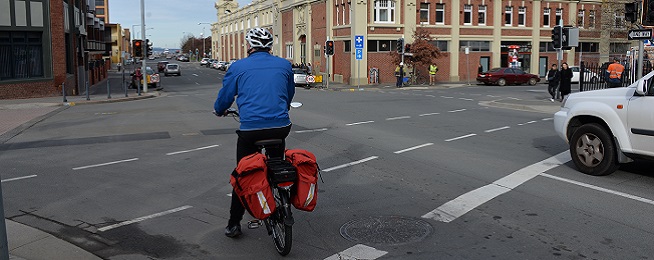At our recent Bike Futures seminar, participants headed out on Campbell Street in Hobart to look at the opportunities and challenges for installing a separated bicycle lane.
The one-way Campbell Street could be one of the first places in Hobart for a separated bicycle lane.
Two new cycling and pedestrian bridges are to be built later this year that will link the Intercity Cycleway and suburb of Glebe to the corner of Campbell and Bathurst streets in the city.
The City has yet to release any street plans for how riders would enter and exit the bridge on Bathurst Street..
For the past year, one lane of traffic between Liverpool and Collins Street has been blocked for construction of a new hospital and many drivers have adapted their journeys accordingly.
The hospital and new university performing arts school are due to finish in mid–late 2019, and the footpaths and road will need to be updated once that construction finishes.
Bike Futures participants broke into four groups with some of our speakers and City of Hobart and university staff as walk leaders.
They looked at issues such as bus stops, on-street parking, footpath and traffic lane widths, intersections, and which side of the street would suit a separated cycleway.
Most people suggested removing one side of parking to make room for a cycleway, although a few also went for removing a traffic lane or narrowing existing lanes.
There wasn’t as much agreement about which side the cycleway should go on, however, with some in favour of the western side where the painted bike lane currently is and others opting for the eastern side.
Or whether a separated cycleway should be bi-directional or one way. One person suggested looping a cycleway from Campbell down Argyle Street to meet up with the Intercity Cycleway extension.
There was consensus on needing to change the Davey and Campbell streets intersection, with several suggestions for a “scramble crossing”, which allows people walking and riding to cross the entire square at whatever angle suits them.
Key considerations in any design for the street are bus movements, ambulance movements and hospital pick-ups and drop-offs.
Feedback from the exercise will be sent to the City of Hobart’s bicycle advisory committee.
The City is also calling for feedback on its draft Transport Strategy, which includes several recommendations affecting bicycle riders, including the recommendation for a new bike plan for the city.


